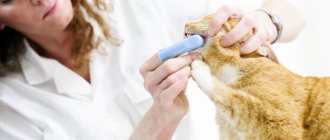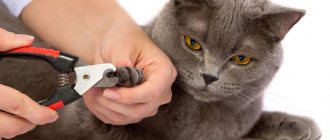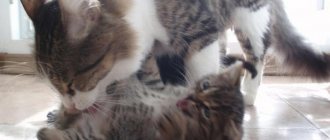Pregnancy of a pet is a joyful and important event. Cats become sexually mature by 6-8 months and, if the owner does not plan to sterilize her, you need to be prepared for childbirth. When a female gives birth for the first time, it is especially exciting.
Nature made sure that cats did everything on their own, but sometimes it needs to be stimulated. Street animals often find a secluded place and do not bother their owners. But helping a cat give birth in a city apartment is often necessary.
How to prepare? What to do when your cat doesn't push well? What drugs should I use? When to see a doctor? What to do if a cat gives birth for the first time? We will answer these and other questions further.
Possible complications during and (or) after childbirth
From a medical point of view, difficult childbirth in a cat is also called pathological.
Complications can occur at any stage of birth and even after a seemingly successful lambing. Let's consider the main types of complications during childbirth in a cat and measures to prevent them. What should you do if your cat has blood (blood discharge) during or after giving birth? Usually the owner only thinks that his pet is peeing blood after giving birth. In fact, there is nothing alarming about this phenomenon, and if the suspicious symptom goes away after a day or two, then you can forget about bleeding.
But the causes of bleeding in cats after childbirth can be negative:
- Accumulation of blood in the uterus;
- Rupture of the uterus, vulva;
- Broken stitches (after cesarean section).
Therefore, if immediately after birth heavy bleeding is noticed, lasting more than 10 minutes, then you need to take the animal to the veterinarian urgently.
Why does a cat have no milk after giving birth and what to do in this situation? Nature has thought of everything, including the independent ability of a cat to care for and feed its offspring. However, due to various circumstances, cats that have recently given birth may not have milk, or there may be too little milk for adequate feeding.
- First, you need to take care of proper care for the cat, creating a cozy and calm environment for her, conducive to the development of her maternal instinct. You should also take care of the nutritional value of the cat's diet: the food should be nourishing, but balanced. It is advisable to give a young mother more milk.
- It would be nice if you could place bowls of cat food close to the “nest”. After all, many cats faithfully protect their babies and are afraid to go far from them for a long time. This affects the quality of nutrition, and therefore the amount of mother’s milk.
Why did a cat develop a bladder after giving birth and what to do in this case? Most often, the amniotic sac, the membrane in which the kitten developed, bursts while still in the cat’s womb. But every rule has an exception. Sometimes you can see that a pet’s bladder has come out after giving birth - this means that the natural lambing cycle has taken a slightly different path.
If this does not happen, then the cat needs help and burst the bubble on its own. Naturally, all hygienic precautions must be taken before the operation begins.
There are three main reasons why cats may have a big belly after giving birth:
- There are times when a cat does not give birth to all kittens at the same time. In this case, you should wait a little. If after a day the animal does not give birth completely, you should take the pet to the veterinarian. At the same time, you need to be sure that the cat still has a baby in its stomach. To gain confidence, you need to palpate your stomach for the presence of a fetus. It should be borne in mind that this could be a dead kitten, so you should not ignore such a fact as a belly after birth.
- Accumulated gases and feces. A cat that has given birth may suffer from simple constipation caused by the stress and torment of childbirth.
- Helminthic infestations. The animal's body can be filled with parasites. This happens quite often, but, fortunately, deworming solves the problem in the vast majority of cases.
If your pet is on the verge of giving birth, but feels quite confident, then there is no need to stimulate the animal’s labor. But not every cat gives birth without complications. In some cases, animals cannot give birth on their own at all, so human help is the only chance for them to save their offspring, and sometimes even survive themselves.
The easiest way to induce labor in a cat is by stroking the abdominal cavity. In some cases, it is possible to administer drugs to a pregnant pet to intensify contractions, but this should only be done if necessary - when labor is delayed for an unnaturally long period of time.
We suggest you read: Sand for hamsters description pros and cons selection and purchase
Eclampsia most often begins in the first weeks after birth. This is due to calcium deficiency, washed out of the animal’s body. Some cats are predisposed to eclampsia. And if your pet is at risk or has already had to deal with a similar problem in previous births, then a relapse is almost inevitable. In this case, you need to develop a diet for a pregnant cat with an increased dosage of calcium.
The onset of labor is usually accompanied by a loud meow from the woman in labor. The birth of kittens begins with the release of amniotic fluid. Then, about a few hours before the birth of the first kitten, weak contractions begin and increase in intensity until the cervix is completely dilated. After the uterus opens, contractions become rhythmic, from which we can conclude that kittens will soon be born.
The norm is considered to be contraction of the uterine muscles at intervals of 2-3 minutes; the woman in labor can take a sitting position. The water bubble comes out first, then the head or paws of the first kitten are shown. Each subsequent newborn is born within half an hour, sometimes within an hour. After the last kitten is born, you need to make sure that the cat has removed the amniotic sac from each one.
Any anomalies negatively affect the health of both cats and kittens. The most common cause of complications during childbirth is weak labor (weak contractions of the cat's uterus). There are two types of this phenomenon:
- 1. The primary slight tone of the uterus is that the body does not have the required amount of a hormone called Oxytocin. It enters the blood from the pituitary gland and affects the frequency of uterine contractions. Often PLTM (primary light uterine tone) is associated with a lack of calcium. In most cases of difficult births, it turns out that the cat has a deficiency of both hormones. In such cases, injections are given using medications such as Pitocin (Oxytocin) and calcium gluconate. They will help the uterus contract stronger and more frequently.
- 2. Secondary slight tone of the uterus is that the organ stops contracting due to severe exhaustion of the cat during labor. VLTM occurs when childbirth is much more difficult and longer than the animal’s body can withstand.
There are three stages of labor:
- The first stage is characterized by the occurrence of uterine contractions and the opening of the cervix (readiness to give birth). In this case, the cat begins to purr strongly, which allows her to relax.
- The second stage is when the kitten is pushed out of the uterus. The birth process lasts on average fifteen hours. With pathology, labor can take seventy-two hours, and this is considered normal.
- The third stage lies in the exit of the birth place. During a multiple pregnancy, the cat moves from the third stage to the second, and so on several times. It is necessary to ensure that exactly as many birth places should emerge as kittens were born. If there is a discrepancy, it is better to take the cat to the doctor.
Problems during childbirth are rare. But you need to prepare for different developments in the process. First you need to check whether all medications and disinfectants are in the first aid kit, sterile wipes, scissors, Vaseline, Oxytocin (will help induce labor), sterile gloves, rubbing alcohol, syringes, etc. There may be no need to use medications, but they should be in the first aid kit.
When and how to use medications:
- Vaseline is necessary when a kitten is born, when the head is already visible, but the cat is unable to push it out.
- Gloves will come in handy if a kitten is born but the placenta has not been delivered. Then you need to get it yourself. If this is not done on time, the woman in labor will experience blood poisoning. The open birth canal is susceptible to attack by microbes, which then causes inflammation of the uterus, so you need to act quickly.
- If the cat cannot cope with the pushing itself and is unable to give birth, it is necessary to use the drug Oxytocin. The injection dosage is 0.2 ml intramuscularly.
We invite you to read: Otitis media in cats: home treatment methods. Otitis media in cats: causes and standard treatment methods
But there are cases when you need to immediately contact a veterinarian. If labor is prolonged and the cat is already in labor for the second day, her temperature rises, she starts bleeding, and she is shaking. Even if it is not possible to go to the hospital, you can get a doctor’s consultation by calling.
Obstetrics
- if the bubble is intact and/or the baby goes with its head, you need to wait for the next contraction - the cat will push the kitten out. This is exactly what happens in the vast majority of cases;
- if the bladder is ruptured, you can help - after waiting for the contraction, take the kitten with a piece of gauze and lightly pull it in an arc down towards the stomach. All manipulations are performed using surgical gloves. If it is uncomfortable to operate with gloves, or you feel stiff, you need to treat your hands with alcohol (nails should be filed short);
- if the bladder is ruptured and the kitten is walking butt, you need to get the baby out as soon as possible, as he may suffocate. Pull gently, only during a contraction, in an arc towards the stomach. Under no circumstances should you drag a kitten by grabbing a part of the body or the head.
- We are waiting for the next contraction and the moment when the bubble appears at the vulva;
- With your index finger we penetrate the vulva in the lower part, just a few millimeters, and gently press on the perineum towards the anus, expanding the passage. Dry birth canals can be moistened with sterile petroleum jelly. Perhaps this will be enough;
- when the head comes out and the shoulders or at least one shoulder appear, with your free hand we carefully take the kitten (not by the head) and little by little swing it to the sides and down in an arc with a light, gentle effort, gradually pulling it out.
- light massage of the tummy in a circular motion, starting from the chest towards the vulva, very gently, without pressure;
- gentle nipple massage;
- if at least one kitten has already been born, you need to put it to your chest and let it eat;
- light massage of the vaginal vestibule, you need to insert your index finger up to the second phalanx and gently stroke the vaginal wall opposite the anus;
- 0.3 ml of oxytocin intramuscularly, every thirty minutes, maximum three injections.
Assistance during childbirth
Before giving birth, the animal becomes restless and constantly meows anxiously. The cat should be immediately transferred to the prepared box. Then her plug comes off, followed by water, after which contractions begin. Breathing becomes intermittent and the cat constantly looks under the tail. She waits for a strong contraction to push the kitten out.
You can help a cat during childbirth at home by first of all you need to calm the animal down and show that the owner is nearby. This is especially important if this is the first birth. Typically, cats give birth on their own, chew the umbilical cord and lick the kittens. But there are different situations. If something goes wrong, then you just need to help the cat give birth at home.
There should be as many kittens born as there are placentas delivered. Otherwise, the cat may develop inflammation, which often leads to death. There are situations when the baby may get stuck in the birth canal and you need to help the cat give birth. It is necessary to lubricate everything well with Vaseline and carefully pull the kitten out by the paws, but not by the head.
If the situation is out of control and the owner does not know what to do when a cat gives birth, you should immediately call a veterinarian. The specialist will provide the necessary assistance so that the animal can give birth faster. If the process is delayed, obstetric assistance is required. To do this, the animal must be injected with Oxytocin, which will stimulate contractions.
Is it possible to induce labor in a cat on your own? In some cases, it is not only possible, but also necessary. As a rule, pregnancy in cats lasts 55-60 days. A slight delay in the birth of kittens is normal, but if the animal does not give birth 68-70 days after mating, measures must be taken. The babies grow in the mother's womb, becoming larger and larger, and the larger the kittens, the more complications the birth will be.
Calling a doctor or an urgent trip to the clinic is necessary in the following cases:
- 1. More than one hour has passed since the beginning of the first contraction, or the contractions are weak.
- 2. The cat's body temperature has risen or fallen.
- 3. The cat began to feel noticeably worse, lies and does not move.
- 4. The fruit is stuck.
- 5. The cat's heartbeat is disturbed and it begins to shake.
When to urgently contact a veterinarian
After giving birth, the cat should gradually recover. She gains strength, she begins to move around and feed her offspring.
But there are cases when the animal becomes lethargic for a long time, and discharge forms in the genitals. The pet refuses to eat. This is a reason to contact a veterinarian. The cat's body temperature may rise greatly and convulsions may begin. All this can lead to her death if timely treatment is not started.
Childbirth is a natural process for cats, but in some cases it is complicated. Therefore, the owner needs to know what to do during this period. This applies to any pet, be it a purebred British cat or an ordinary yard cat. Complications may occur during the first or each subsequent birth.
Already at 8 months the cat reaches sexual maturity. If the owner does not plan to sterilize his furry pet, he needs to be ready to deliver when the time comes. Knowing how to help a cat give birth and what to do if complications arise can save the life of the animal and its offspring.
Medicines
You can induce labor in a cat at home using some medical means:
- Oxytocin. It causes contractions of the uterus and helps speed up the labor process. This synthesized hormone can only be used after consultation with a veterinarian.
- Travmatin. Relieves pain and helps regulate contractions, helps avoid complications and injuries while the animal is giving birth, promotes healing and prevents inflammation.
- Gamavit. Stimulates the uterine muscles, facilitates childbirth in difficult cases.
- Calcium gluconate. Not only stimulates labor, but also helps milk production.
Possible complications during and (or) after childbirth
During the birth process it is not allowed:
- use human disinfectants;
- pulling newborns' limbs;
- Turn on bright lights in the room after the kittens are born, they may have vision problems in the future.
It is also important to ensure that the cat does not eat more than two afterbirths.
After giving birth, a person should not touch the kittens; the mother cat will regard this as a threat to the children’s lives. Such actions can result in death or injury to the kittens. It is advisable to leave the woman in labor alone for several days, but still continue to monitor her.
We suggest you read: Soft tissue sarcoma in cats
Immediately after birth, it is necessary to tidy up the nest, replace the diapers with clean and light ones so that the color of the discharge can be seen on them. It is necessary to check that all kittens are actively suckling their mother.
The cat does not give birth for the second day - what to do?
What to do if the cat cannot give birth on the second day? This situation is critical and indicates the owner’s lack of awareness in matters of cat birth.
If the cat's contractions have disappeared, but she has become lethargic, apathetic and weak, then this indicates the beginning of the inflammatory process. In this case, the kittens are already dead and the owner needs to urgently deliver the pet to the clinic to save its life. In this case, surgical intervention is indicated.
How to act
If there is a need to induce contractions in a cat, you need to use Oxytocin. This drug will help strengthen the tone of the muscle tissue of the uterus before labor begins. The medicine is administered intramuscularly or subcutaneously; its effect begins within 2-3 minutes after the injection. It is very important to follow the dosage, otherwise complications may arise, including the death of the kittens.
How much drug should I use? For cats, the following dosage should be used: 0.2-0.3 ml for intramuscular or subcutaneous injection, the injection is given between two contractions. If there is no result within 1/3 hour, the drug is re-administered at the same dose. The maximum number of injections is 3; if there is no effect, you cannot increase the dosage - this will lead to negative consequences.
How to give an injection? To help your pet give birth to offspring, you should inject the drug into the withers. To do this, the animal’s skin is grabbed with one hand and an injection is made into the hollow formed at the back. It is important to puncture the skin and inject the drug between the skin and muscles.
Stages of kitten birth
Let's look at the birth process in stages.
Remember what you should do at each stage to alleviate the animal’s condition:
- The birth canal opens. The animal must be placed in the nest. Try to calm the cat: pet it, talk to it affectionately.
- Attempts begin. The muscles contract, grayish-reddish water comes out of the vagina. The amniotic sac ruptures, and the kitten begins to move along the birth canal. The cat should lie on its side during this period. Try to gently but persistently fix her in this position. If the animal begins to worry and jumps up on its paws, the kittens may suffer.
- The first kitten is usually born after about half an hour. You need to wipe the liquid off the kitten's face so that it doesn't get into your nose.
- The placenta comes out. Under natural conditions, animals eat it. However, a domestic cat is only allowed to eat three afterbirths. The rest should be thrown away.
- Rest between births of kittens. The cat needs to gain strength before the birth of the next baby. The animal needs to be calmed, caressed, and given warm milk to drink.
Gamavit and calcium gluconate
This traditional medicine is recommended to be used to help cats during childbirth for several reasons:
- It helps to avoid uterine rupture due to excessively large offspring;
- It prevents diseases such as endometritis and pyometra.
- Reduces the risk of birth and postpartum complications.
- Allows the animal to quickly return to normal after birth.
The product is used by injection - intravenous, subcutaneous and intramuscular. To speed up the absorption of the medicine into the blood and induce labor, the injection should be given under the shoulder blade. In agreement with the veterinarian, the drug can be given to the cat to drink. For an adult cat, the dosage of the drug for one injection can be from 1 to 1.5 ml.
If a pet had a difficult birth or the owner had to stimulate it, then the cat is in a weakened state. You can help her with an injection of Gamavit, a veterinary drug based on placental emulsion. And calcium gluconate will help normalize metabolism.











